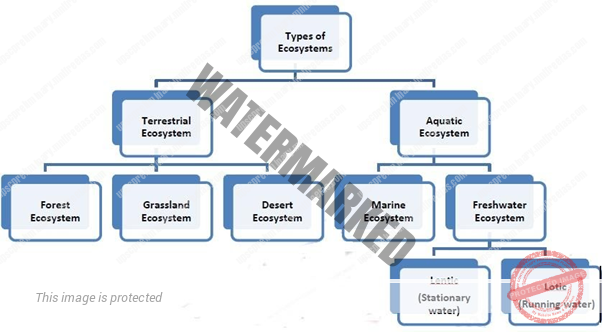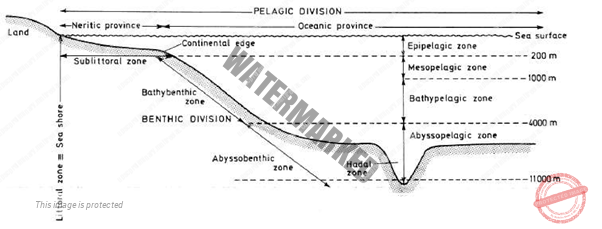- TYPES OF ECOSYSTEMS
- TERRESTIAL ECOSYSTEMS
- FOREST ECOSYSTEM
- GRASSLAND ECOSYSTEM
- DESERT ECOSYSTEM
- AQUATIC ECOSYSTEMS
- MARINE ECOSYSTEMS
- PELAGIC MARINE ECOSYSTEM
- CORAL REEF ECOSYSTEM AND MANGROVE SWAMP ECOSYSTEM
- COASTAL ECOSYSTEMS
UNIT 1 – ECOLOGY & ECOSYSTEM – PART 2
TYPES OF ECOSYSTEMS
All types of ecosystems fall into one of two categories:
Terrestrial or Aquatic. Terrestrial ecosystems are land based, while aquatic is water based
TERRESTRIAL ECOSYSTEMS
The distribution of terrestrial ecosystems is primarily related to Precipitation and Temperature. Terrestrial ecosystems can be divided, mainly on the basis of the prevailing vegetation type, into three basic categories:
- Forest Ecosystem
- Grassland Ecosystem
- Desert
FOREST ECOSYSTEM
Forest ecosystems cover large parts of the terrestrial land surface and are major components of the terrestrial carbon cycle. Trees, the main component of forest ecosystems, contain the largest stock or absolute quantity of the living forest biomass.
Its direct offerings include Forest Biomass, Timber and a series of other forest products, storehouse of genetic material acting as genetic reservoir for future improvements of Agricultural Production and the most significant, along with the oceans, shelters of the planet’s wildlife.
Forest ecosystems correspond also to a wide range of humidity values, from dry to very humid regions. Forest ecosystems correspond also to a wide range of humidity values, from dry to very humid regions
- Tropical Rainforests
- Temperate Deciduous Forest
- Temperate Evergreen Forest
- Tropical Dry Forests
- Taiga
- Tundra
GRASSLAND ECOSYSTEM
Grassland ecosystems are ecologically and economically important and are of widespread occurrence.
The distribution of grassland ecosystems to a large extent is determined by Climatic Variables, Principally Temperature & Precipitation.
Three factors including:
- Drought
- Fire
- grazing by large ungulate herbivores, distinguish grasslands from other ecosystem types.
They are located in areas in which water availability is below the requirement for the forest at some time during the year but is sufficient to support grasses as the dominant plant type.
Grasslands in the wider sense are among the largest ecosystems in the world; their area is estimated to be 40.5 percent of the terrestrial area excluding Greenland and Antarctica
- Tropical Grasslands (also called savannas)
- Temperate Grasslands (also known as prairies or steppes)
- Mediterranean Shrublands (also called chaparral)
DESERT ECOSYSTEM
Deserts cover 17% of the world’s land mass and harbor almost one-third of terrestrial global carbon stock. A desert often is defined as an area that receives less than 10 inches (25.4 cm) of unevenly distributed precipitation over the year. Much of this land lies between 15° and 30° latitude. The most important factors that affect life in the desert biomes include radiation, heat and temperature, wind, water, and nutrition
Despite their Aridity, Desert ecosystems support a surprising diversity of animal life, including a wide assortment of Beetles, Ants, Locusts, Lizards, Snakes, Birds, And Mammals
Some desert plants use deep roots to tap into groundwater Others such as prickly pear and saguaro cacti use widely spread shallow roots to collect water.
AQUATIC ECOSYSTEMS
An important determiner of the nature of aquatic ecosystems is the amount of salt dissolved in the water. Those that have little dissolved salt are called Freshwater Ecosystems, and those that have a High Salt Content are called Marine Ecosystems.
MARINE ECOSYSTEMS
In oceans the surface area lighted by the sun is small compared to the total volume of water. This small volume of sunlit water and the dilute solution of nutrients limit primary production.
Temperature also decreases with depth. Warm, bright, near-surface communities, such as Coral Reefs & Estuaries, are among the world’s most biologically productive environments. Temperature also affects the amount of oxygen and other elements that can be absorbed in water.
There are two major divisions of the environment,
- The Pelagic
- The Benthic
the Pelagic Division comprising the whole body of water forming the seas and oceans, and the Benthic Division the entire sea bottom
PELAGIC MARINE ECOSYSTEM
THE PELAGIC is divided into two provinces: the neritic province, water that overlies the continental shelf, and the oceanic province. Because conditions change with depth, the pelagic is divided into several distinct vertical layers or zones
Pelagic Zone can be further subdivided into Ecological Zones based on depth: in the Epipelagic Or Photic Zone(0-200m) , there are sharp gradients in illumination, temperature, and salinity;
The Mesopelagic (200-1000m), has little light to penetrate and the temperature gradient is more even and gradual, without much seasonal variation and this zone contains an oxygen-minimum layer and often the maximum concentration of nutrients (nitrate and phosphate)
The bathypelagic (1000-4000m), darkness is virtually complete, except for bioluminescent organisms; temperature is low; and water pressure is great; and the abyssopelagic region (4000 to 6000m).
Areas deeper than 6000m are called Hadal Pelagic Regions – (for example, the Mariana trench is a hadal environment).
which includes areas found in deep-sea trenches and canyons, while they account for the deepest regions on the planet’s oceans, they compose a very small fraction of the total oceanic environment.
The pelagic environment is home to two basic groups of marine organisms. The first group consists of the plankton (Greek for “wandering”) which is appropriate because they possess little power to “swim” any significant distance and are thus passively transported by ocean currents. Planktonic plants are known as phytoplankton, and planktonic animals are known as zooplankton (e.g., jellyfish, small crustaceans, pelagic snails, etc.).
CORAL REEF ECOSYSTEM AND MANGROVE SWAMP ECOSYSTEM
They fall in the Neritic province. Coral reefs are among the best-known marine systems, because of their extraordinary biological productivity and their diverse and beautiful organisms. Reefs are colonies of minute, colonial animals (coral polyps) that live symbiotically with photosynthetic algae.
Calcium-rich coral skeletons shelter the algae, and algae nourish the coral animals. Although various types of corals can be found from the water’s surface to depths of 6000 m, reef-building corals are generally found at depths of less than 45 m.
MANGROVES are the dominant ecosystems that line the coasts of subtropical and tropical coastlines around the world. Mangroves are a diverse group of salt-tolerant trees that grow along warm, calm marine coasts around the world. Growing in shallow, tidal mudflats, mangroves help stabilize shorelines and build land by trapping sediment and organic material.
Both marine species (such as crabs and fish) and terrestrial species (such as birds and bats) rely on mangroves for shelter and food. Mangroves are found in Sundar Bans in India, South Florida, the Caribbean, Southeast Asia, Africa, and other parts of the world where tropical mudflats occur.
COASTAL ECOSYSTEMS
A coral reef is an underwater ecosystem characterized by reef-building corals. Reefs are formed of colonies of coral polyps held together by calcium carbonate. Most coral reefs are built from stony corals, whose polyps cluster in groups.
Coral belongs to the class Anthozoa in the animal phylum Cidaria, which includes sea anemones and Jellyfish. corals secrete hard carbonate exoskeletons that support and protect the coral.
Corals are called Rainforests Of The Sea, shallow coral reefs form some of Earth’s most diverse ecosystems. They occupy less than 0.1% of the world’s ocean area, about half the area of France, yet they provide a home for at least 25% of all marine species, including Fish, Mollusks, Worms, Crustaceans, Echinoderms, Sponges, Tunicates And Other Cnidarians.
Coral reefs are built around coral, a coelenterate animal, related to the jellyfish and sea anemones in the warm waters of tropical and subtropical oceans.
The animal forms a colonial structure embedded in a skeleton of calcium carbonate or it’s mass. Within the cells of the coral there occur numerous cells of symbiotic endozoic algae, dinoflagellates. Thus, the coral represents a partnership, with the algae providing food, and the coral giving structural support and nutrients to algae.
Most of a coral’s energy is produced by microscopic plants called ZOOXANTHELLAE that live within the coral. These zooxanthellae actually give corals their beautiful colours.
The coral also feeds on plankton of water, and by doing so procures nutrients to be used by its partner, the dino flagellates. By maintaining a highly efficient nutrient cycling and high level of nutrient conservation, the coral reefs attain high productivity.
Like Tropical Rainforests, Their Species Diversity & Richness in form and colour are tremendous. The coral reef communities include Calcareous Bryozoans, Polychaete Worms, Molluscs
(All Occurring in Coral Mass); Sea Anemones, Sponges, Crabs, Snails And Echinoderms (occurring in abundance in association with the ecosystem).


